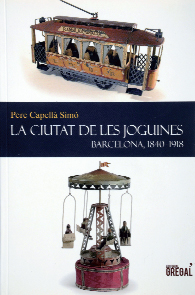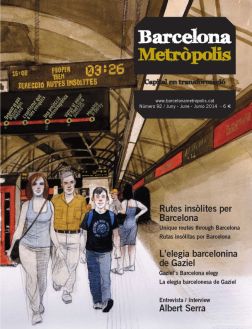 La ciutat de les joguines [City of Toys]. Barcelona, 1840–1918
La ciutat de les joguines [City of Toys]. Barcelona, 1840–1918- 2013 Agustí Duran i Sanpere Barcelona History Prize
- By: Pere Capellà Simó
- Editorial Gregal and Barcelona City Council
- Maçanet de la Selva, 2014
- 436 pages
Toys are historical objects. The teacher, researcher and painter Pere Capellà Simó (Palma, 1981) confirms that in his book La ciutat de les joguines [City of Toys], which merited the 2013 Agustí Duran i Sanpere Barcelona History Prize, awarded in February as one of the City of Barcelona awards.
Toy development at the turn of the 20th century suggests a review of that period’s history, which saw a twinning of art and industry that symbolised the economic and cultural expansion of the rising bourgeoisie. The end of the Franco-Prussian War led to a golden age of toys. A huge toy industry was born. Germany was the main European producer and Paris was the centre of innovation. The first adverts by craft toy makers in Barcelona were distributed in 1840. Catalonia’s capital welcomed branches of French and German companies. The city established itself as a European metropolis and became the home of 60 toy factories and a hundred specialist toy shops. But the Great War would force the warring nations to halt toy production, leaving Barcelona, followed by Valencia and Madrid, to drive the sector forward. The first collections of Apel·les Mestres, the sketch artist Lola Anglada, Maria Junyent and the painters Manuel Rocamora and Lluís Tolosa were established. They were followed by another generation. The sculptor Frederic Marès built the Sentimental Museum of the 19th century and the painter Alfred Opisso i Cardona gathered together the toys of his childhood.
The book explores the world of toys during the years of Modernisme, Catalan Art Nouveau, and an industry that was within the reach of a large part of the population. In the 19th century childhood was long and, according to Charles Baudelaire, toys would become a child’s first contact with art. Intellectuals called for collaboration between prestigious artists and toy manufacturers, so that aesthetic criteria and refined taste would be developed before adulthood.
Readers will notice the importance the author attaches to the symbolic value of shop windows. Like the hole through which Alice enters wonderland, for a child, toy counters represent the happiness they wish for. Many families without means copy the toys they see there using materials closer to hand and, fascinated, we adults project our own experiences onto them.
La ciutat de les joguines arose out of a doctoral thesis that Capellà Simó presented in 2012. His research has two further threads, namely, Barcelona-Palma and the Paris model, which will inspire future publications. This work is not a novel but the direct, precise, straightforward style means you dive into it as if it were an entertaining narrative, with stories like that of Salomon Heischmann, director of the Société Française de Fabrication de Bébes et Jouets, who took refuge in Barcelona in August 1914.
Capellà Simó is the curator of the future permanent doll exhibition at the Museu Romàntic in Sitges and he warns us that shop windows have been replaced by museum display cases. All things considered, the development of toys is our own history written in small print, that of personal, everyday happenings, which is just as important as that of the great events.



dentro de poco comprare el libro..soy coleccionista…….
espero se difunda copias de los antiguos catalogos de juguetes de esos años…el que los tiene no lo ofrece a otros coleccionistas
indica el ISBN del libro